Table of Contents
THE CONTEXT: In June 2021, the export of about 500 tonnes of rice from India has triggered an uproar in several European countries on the grounds that it was genetically modified (GM) rice. It was due to the use of one ingredient: rice flour with genetically modified (GM) contamination that allegedly originated in India, according to notifications on the European Commission’s rapid alert system.
However, the Indian government has denied this possibility with a Commerce Ministry spokesperson alleging that the contamination may have happened in Europe “to cut costs”. In this backdrop, India has indicated that it will commission an investigation involving its scientific bodies.
In this article, we will analyse, what are GM crops, their merits, implications, causes and their way forward for India.
WHAT IS THE ISSUE?
India asks European Commission to back up GM-rice claims with evidence
The Centre has identified a Maharashtra based exporter as Omprakash Shivaprakash, a wholesaler from Akola in Maharashtra.
Also, it’s stated, “There is no possibility of cross-contamination even during inland transit as the final sample was prepared at the port of loading by an independent inspection agency which is internationally accredited, which after proper testing and verification have obtained a non-GMO proof prior to shipment, the certificate was issued by Bureau Veritas (India) Pvt Ltd.
“GMO contamination was suspected in rice flour that was processed in the European Union, and they themselves are not sure of the exact source of the contaminant. Exported from India,” a commerce ministry statement said. Broken white rice, which is reportedly one of the possibilities, has passed through several hands before reaching the actual processors in the European Union.
Reiterating that GM rice is not grown commercially in India, the ministry has asked genetic and rice experts including the Indian Agricultural Research Institute (IARI) to conduct an investigation.
WHAT ARE GM CROPS?
- Genetically Modified Organisms are defined as organisms including plants, animals, and micro-organisms in which the genetic material (DNA) is altered in a way that does not occur naturally by mating or natural recombination.
- The technology used is referred to as gene technology, genetic engineering, or recombinant DNA technology. GM crops are those crops whose DNA has been modified by introducing alien genes in the seeds to get desired effects such as resistance to pest attacks.
- Unlike what plant breeders did traditionally in cross-breeding by combining genes from the same or closely related plant species, GM technology does not restrict trait selection. Genes from any living organism, be it plants or animals, is used to arrive at the desired traits.
- India has approved the commercial cultivation of only one GM crop, Bt cotton. No GM food crop has ever been approved for commercial cultivation in the country. However, confined field trials have been allowed for at least 20 GM crops.
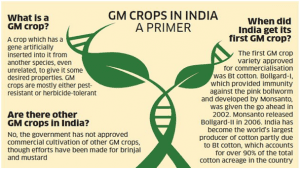
GM CROPS IN INDIA
Golden rice: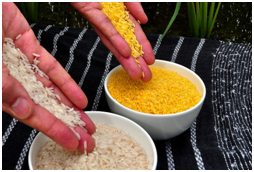
It is a variety of rice produced through genetic engineering to biosynthesize beta-carotene, a precursor of vitamin A, in the edible parts of rice. It is intended to produce a fortified food to be grown and consumed in areas with a shortage of dietary vitamin A.
Vitamin A deficiency causes xerophthalmia, a range of eye conditions from night blindness to more severe clinical outcomes such as keratomalacia and corneal scars, and permanent blindness. It also increases the risk of mortality from measles and diarrhoea in children.
In 2013, the prevalence of deficiency was the highest in sub-Saharan Africa (48%; 25–75), and South Asia (44%; 13–79).
Although golden rice has met significant opposition from environmental and anti-globalisation activists, more than 100 Nobel laureates in 2016 encouraged the use of genetically modified golden rice which can produce up to 23 times as much beta-carotene as the original golden rice
Bt Cottons:
Bacillus thuringiensis (Bt) cotton is a genetically modified plant. For the time being, the genetically modified crop that is under cultivation in India is Bt cotton which is grown over 10.8 million hectares. Bt Cotton was first utilize in India in 2002.
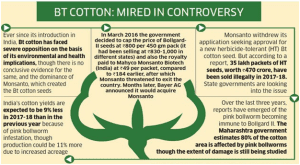
Bt Brinjal:
The Genetic Engineering Appraisal Committee (GEAC) in 2007 recommended the commercial release of Bt Brinjal, which was developed by Mahyco (Maharashtra Seeds Company) in collaboration with the Dharwad University of Agricultural Sciences & the Tamil Nadu Agricultural University. But the proposal was blocked in 2010.This has been commercially grown in Bangladesh since 2013.

GM Mustard: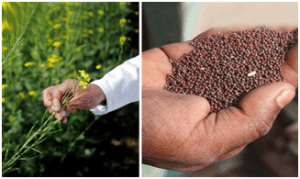
Dhara Mustard Hybrid-11 or DMH-11 is a genetically modified selection of mustard developed by the Delhi University’s Centre for Genetic Manipulation of crops plants.
The researchers at Delhi University have created hybridized mustard DMH-11 using “barnase or barstar” technology for genetically modification. GM Mustard is an herbicide Tolerant (HT) crop.In 2017, GEAC has recommended the commercial approval of our first food biotech crop. With the decision pending with the environment ministry, the farming and scientific community hopes that GM mustard will get clearance soon. If approved by the centre, this will be the second GM crop, after Bt Cotton, and the first transgenic food crop to be acceptable for cultivation in the country.
WHAT IS THE LEGAL POSITION OF GENETICALLY MODIFIED CROPS IN INDIA?
- Constituted under the ‘Rules for the Manufacture, Use /Import /Export and Storage of Hazardous Microorganisms/Genetically Engineering Organisms or Cells, 1989’ notified under the Environment (Protection) Act, 1986.
- In India, the Genetic Engineering Appraisal Committee (GEAC) is the apex body that allows for the commercial release of GM crops.
- In 2002, the GEAC had allowed the commercial release of Bt cotton. More than 95 per cent of the country’s cotton area has since then come under Bt cotton.
- Use of the unapproved GM variant can attract a jail term of 5 years and a fine of Rs 1 lakh under the Environmental Protection Act,1989.
- In August 2020, FSSAI had also issued the order that 24 food crops the country imports would need a ‘non-GM-origin-cum-GM-free certificate’.
- FSSAI is the authorized body to regulate the imported crops in India.
ADVANTAGES OF GM CROPS
- The Main advantage of genetically modified foods is that crop yields become more consistent and productive, allowing more people to be fed. According to Oxfam, the world currently formed about 20% more food calories than what is required for every human being to be healthier.
- It improves production and raises farmers income. Indian farmers are still practising the traditional procedure of seeding and cultivation, which required scientific moves for raising their production. Hence, it is one of the moves to develop farm production.
- GM foods have a longer shelf life. This enhances the ease of transportation and storage. Also, GM crops are high yielding crops but the problem lies in the fragmentation of land.
- GMOs may have fewer pesticides. Many GMO crops have been altered to be less vulnerable to insects and other pests. For example, Bt-cornis a GMO crop that has a gene added from Bacillus thuringiensis, a naturally occurring soil bacteria. This gene causes the corn to produce a protein that kills many pests and insects, helping to protect the corn from damage.
- GMOs are usually cheaper. GMO crops are bred to grow efficiently – this means that farmers can produce the same amount of food using less land, less water, and fewer pesticides than conventional crops. In some cases, the costs of foods like corn, beets, and soybeans may be cut by 15% to 30%.
- GMOs may have more nutrients. Certain GMO crops are designed to provide more nutrients like vitamins or minerals. For example, researchers have been able to create a modified form of African corn that contains:
- 2 times as much folate when compared to traditional crops
- 6 times as much vitamin C when compared to traditional crops
- 169 times more beta-carotene than traditional crops. This may be especially helpful in regions where people suffer from nutritional deficiencies.
CONCERNS OF GM CROPS
- The production imposes high risks to the disruption of ecosystem and biodiversity because the ‘better’ traits
 formed from the engineering genes can affect the favouring of one organism. Hence, it can eventually disrupt the natural procedure of gene flow.
formed from the engineering genes can affect the favouring of one organism. Hence, it can eventually disrupt the natural procedure of gene flow. - GM Crops increase the cost of cultivation and are more inclined towards marketization of farming that works in immoral profits.
- The transgenic crops endanger not only farmers but also the trade, and the environment as well.
- GMOs may cause allergic reactions. Because GMO foods contain DNA from other organisms, it’s possible that the new DNA can trigger allergies in people who wouldn’t normally be allergic to the food. In one instance, a GMO soybean crop created using DNA from a Brazil nut was unsafe for people with nut allergies and couldn’t be released to the public.
- GMOs may increase antibiotic resistance. When GMO scientists insert new DNA into plant cells, they will often add in an additional gene that makes the modified cells resistant to antibiotics. They can then use an antibiotic to kill off any plant cells that didn’t successfully take in the new DNA.
THE WAY FORWARD
Government should set up an independent regulator at the earliest: In 2014, more than 18 million farmers in 28 countries planted GM crops on 181.5 million hectares. While that in itself is not reason enough for India to push transgenic crops, the government should go beyond what is politically expedient and set up an independent regulator at the earliest. The charged atmosphere surrounding GM crops notwithstanding, the government’s policy should be led by science, not emotions.
Need for Refined Policies, a major global seed maker, says the policy on GM crops needs to be clearly defined, and the government should provide a level-playing field to both public and private sector companies.
Lack of Research & Awareness: Besides the increased incidence of pest attacks, Srinivas has not seen an adverse impact from Bt cotton on his soil or groundwater. His observation may just be anecdotal, but there is not enough conclusive research to counter him. A 2013 study by Italian researchers of 1,783 studies published between 2002 and 2012 did not find any significant hazard to human health, biodiversity, or the environment caused by GM crops.
Niti Aayog released a report that said, “As a part of its strategy to bring a Second Green Revolution, India must return to permitting proven and well tested GM technologies with adequate safeguards. Additionally, India urgently needs a technological breakthrough in oilseeds and pulses.”
Pew Research Centre survey published in January 2015, 88% of American scientists polled found GM foods safe. “GM crops go through the kind of rigorous testing that no other Agri product goes through. There is no evidence of their impacting biodiversity or soil health,”
Similarly, the 2015-2016 Economic Survey has also called for a faster rollout of GM crops: “Concerns about the affordability of hybrids and GM seeds, environmental and ethical issues in the cultivation of GM crops, risks to the food chain, disease spread and cross-pollination have resulted in their non-introduction. These issues need to be debated, tested, evaluated, so that introduction of hybrids is facilitated in the next three to six months.”
THE CONCLUSION
- The second decade of the 21st century, 2011 to 2020, has turned out to be the lost decade for India, as far as agriculture biotechnology is concerned. The GEAC has held only 35 meetings in 10 years and even recommended trials were not held.This contrasts sharply with the previous decade, when the GEAC held almost 81 meetings, and over a dozen GM crops were in various stages of development.
- This is a complete reversal of the fundamental legal philosophy of modern civilisation, which holds that one is innocent unless proven guilty. The yardstick now being used for GM crops is that these crops are inherently dangerous, and therefore presumed guilty unless it can be shown that they are not. But a negative can never be proven.
- The illegal cultivation of HT Bt cotton, Bt brinjal and gave us a clear indication that there is a trend of GM crops from field trials ending up in our farms and food. It is an unfortunate truth that our regulatory system has been found ineffective in curbing this. It is also shocking that GEAC has failed to take effective action to even identify those behind seed supply.
- Indian farmers are the true representatives of Aatmanirbhar Bharat, and their product is the original ‘Make in India’, long before these slogans were coined.
Value Addition:
India’s Rice Export:
India holds more than 85% share of global Basmati Rice exports
- India already accounts for a lion’s share of Basmati rice exports. More than 85% of the global Basmati exports (by quantity and by value) are from India. In India, the quantity of Basmati exported is about 37% of the total rice exported by quantity and 60% by value in 2018-19. During the same period, in Pakistan, Basmati exports comprised 13% of rice exports by quantity and almost 29% by value.
- India’s annual rice exports amount to 18 million tonnes worth Rs 65,000 crores and reach more than 75 countries.
- After exporting a record 17.71 million tonnes of rice in 2020-21, an increase of 86% over the previous year’s 9.5 million tonnes, India is set for another good season of exports in 2021-22 as well, despite high freight costs.
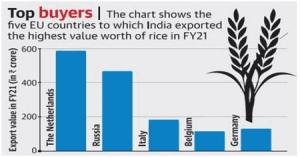


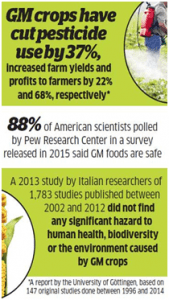 formed from the engineering genes can affect the favouring of one organism. Hence, it can eventually disrupt the natural procedure of gene flow.
formed from the engineering genes can affect the favouring of one organism. Hence, it can eventually disrupt the natural procedure of gene flow.